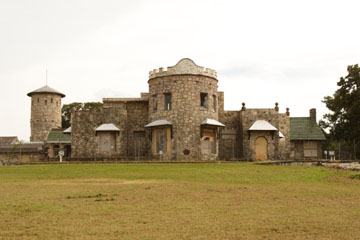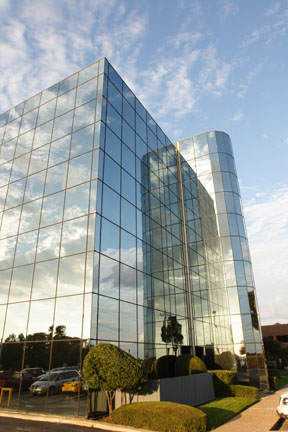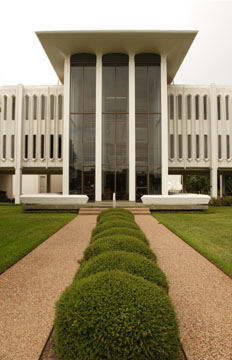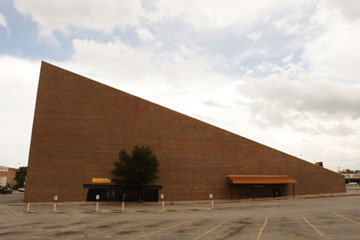 Or the giant factory that lords over I-35 near Belknap. Or the long, flat, dark … thing off in the distance near Western Center Boulevard that’s part enchanting, part scary. Whatever they are, they’re part of our town, and, in their own unique, charming, or sinister ways, help make our town what it is: one weird place, perhaps the only city north of Houston where white-collar business and heavy industry intermingle so easily. In February, the American Institute of Architects released a voter-compiled list of the country’s favorite 150 buildings. Ask a friend who knows absolutely nothing about architecture — you shouldn’t have to look far to find one — to name 10 of the country’s most famous buildings. There’s no doubt that his list will include some of the AIA’s chart-toppers, like the Empire State Building, White House, and Chrysler Building.
Or the giant factory that lords over I-35 near Belknap. Or the long, flat, dark … thing off in the distance near Western Center Boulevard that’s part enchanting, part scary. Whatever they are, they’re part of our town, and, in their own unique, charming, or sinister ways, help make our town what it is: one weird place, perhaps the only city north of Houston where white-collar business and heavy industry intermingle so easily. In February, the American Institute of Architects released a voter-compiled list of the country’s favorite 150 buildings. Ask a friend who knows absolutely nothing about architecture — you shouldn’t have to look far to find one — to name 10 of the country’s most famous buildings. There’s no doubt that his list will include some of the AIA’s chart-toppers, like the Empire State Building, White House, and Chrysler Building.
Yawn!
In response to the national list, which corresponded to AIA’s 150th anniversary, the Fort Worth chapter compiled a local top-25. The group sent questionnaires to all 468 of its members, received 30 responses, and published the results in the July 8 edition of the daily paper of record. All of the usual suspects made the top 10: The Kimbell Art Museum was No. 1, followed in order by Marty Leonard Chapel, Tarrant County Courthouse, Modern Art Museum of Fort Worth, Texas & Pacific Railway Terminal, Will Rogers Coliseum, U.S. Post Office (251 W. Lancaster Ave.), Flatiron Building, Fort Worth Water Gardens, and, at No. 10, Thistle Hill, the home of Electra Waggoner, the daughter of legendary cattle baron A.B. Wharton. Yawn!
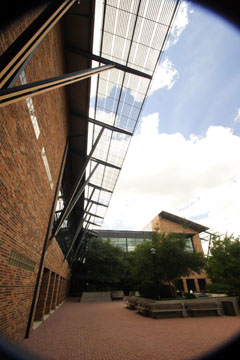 Feeling inspired, we decided to come up with our own — though I am loath to use the term “list.” Actually, it’s more like a conversation about cool buildings. A couple of months ago, I asked readers for their favorite, off-the-beaten-path buildings. We got a few responses. Most of them were unusable (we all know how great the Kimbell is — sheesh), but some were great. Some folks said they loved Building X because it reminded them of a place they lived by when they were kids. Some respondents said they loved Building Y because it’s so ugly that you can’t help but be charmed by its sincere, misplaced confidence. All of which brings up an important and often overlooked reality about architecture: Whether we’re paying attention or not, or whether we’re licensed architects or not, architecture affects all of us. We all have to live, work, or play somewhere, right?
Feeling inspired, we decided to come up with our own — though I am loath to use the term “list.” Actually, it’s more like a conversation about cool buildings. A couple of months ago, I asked readers for their favorite, off-the-beaten-path buildings. We got a few responses. Most of them were unusable (we all know how great the Kimbell is — sheesh), but some were great. Some folks said they loved Building X because it reminded them of a place they lived by when they were kids. Some respondents said they loved Building Y because it’s so ugly that you can’t help but be charmed by its sincere, misplaced confidence. All of which brings up an important and often overlooked reality about architecture: Whether we’re paying attention or not, or whether we’re licensed architects or not, architecture affects all of us. We all have to live, work, or play somewhere, right?
Our goal is simple: to get Fort Worthians talking — and thinking — about architecture. The more we know, the better equipped we’ll be to make decisions about our built environment. And the better equipped we are, the better our city will be. We hope you dig the results. Maybe you’ll see a building or a … thing that you’ve never bothered to notice but discover has an interesting history. Maybe you’ll see something that you always thought was ugly but never realized that its ugliness served a higher, more practical purpose. Maybe you’ll just get pissed. As long as you’re talking, and thinking, about the way our town is, then I think we’ve done our job.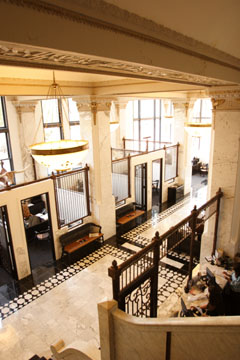
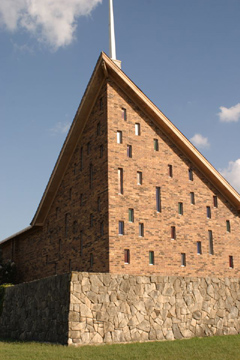
The building everyone loves to hate. Entering the Stockyards on North Main from the south, the casual traveler — upon being greeted by this brown, hulking mass — is liable to react in one of several different ways, specifically “Cool — a pyramid!” or “Now, there’s a bank I’d trust with my money!” or, simply, “What in the name of Betty Buckley is that?” But for a purely Fort Worth architectural experience, nothing beats the Wells Fargo. The behemoth, according to local folklore, was designed to resemble an old-fashioned slaughterhouse ramp — up went the cows, down off the ledge came the delicious Grade-A beef.
